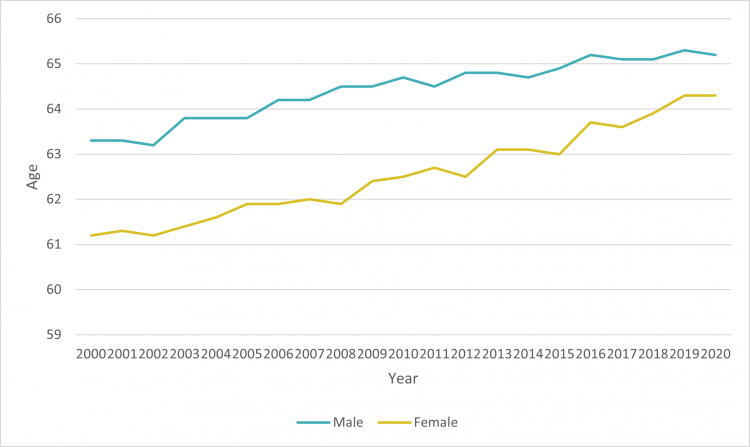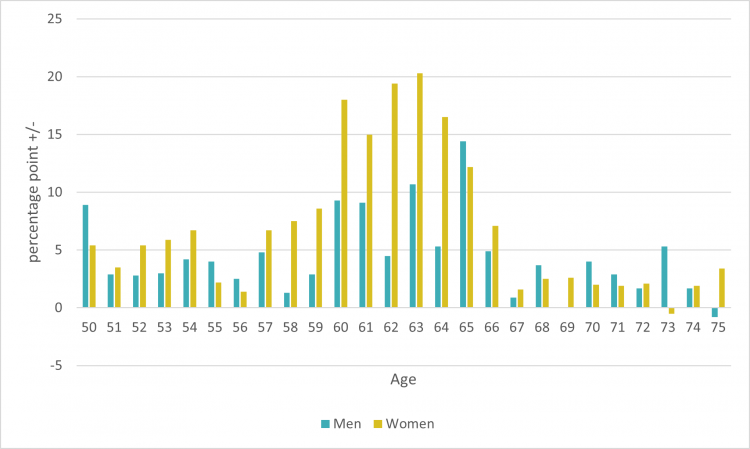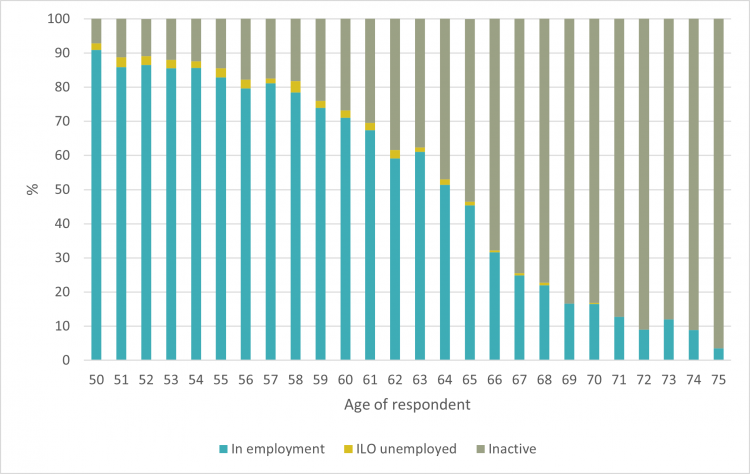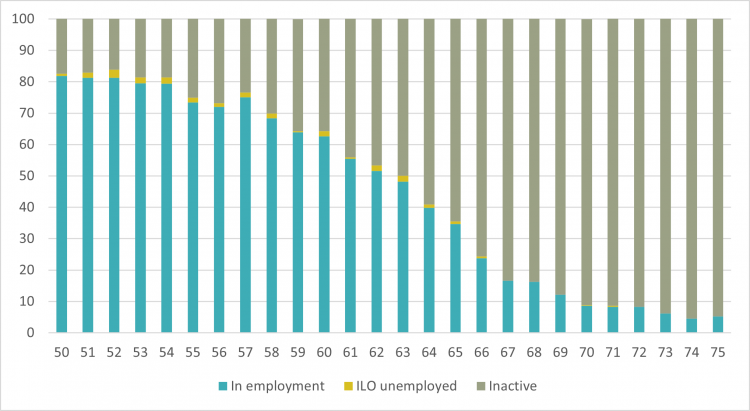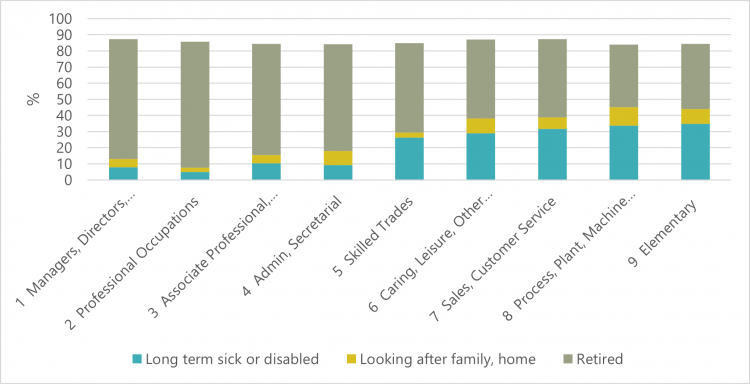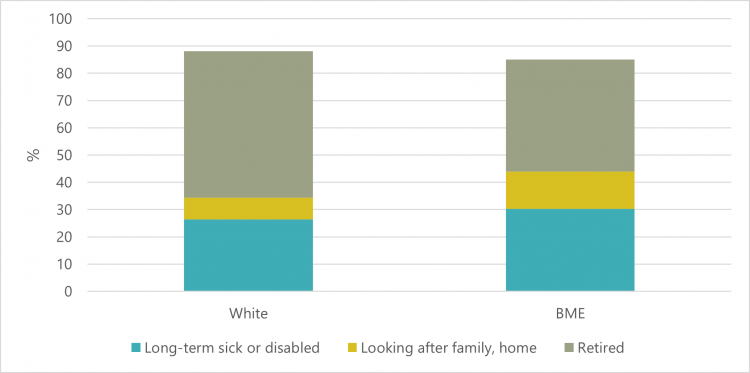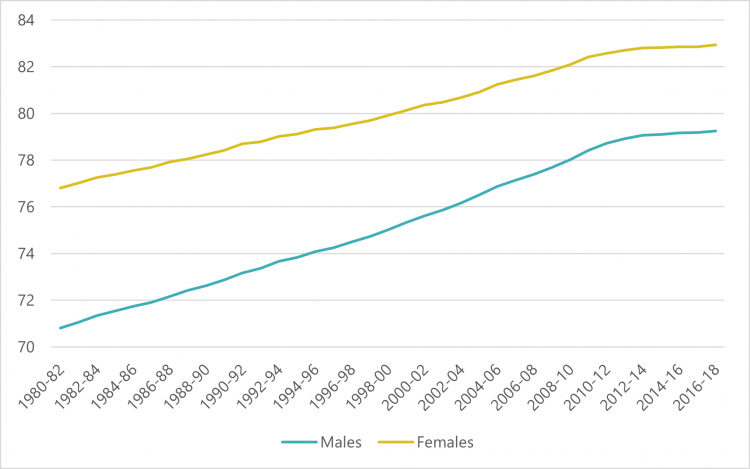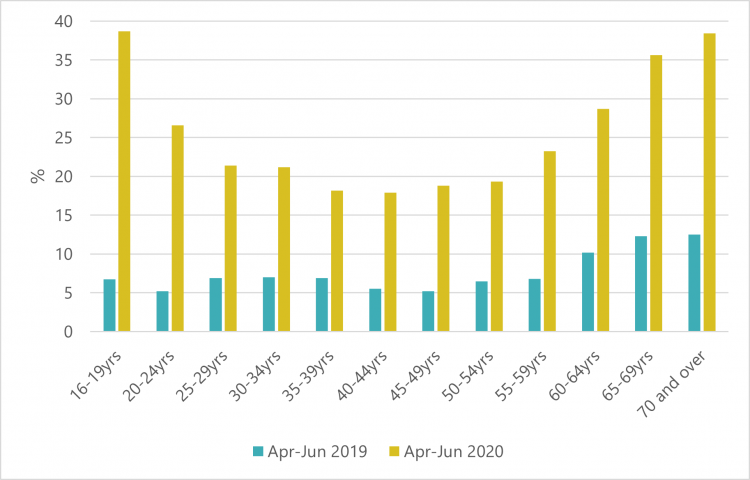Extending working lives - How to support older workers
The economic impact of the pandemic is also likely to fall particularly painfully on older workers, who are more likely than all but the youngest workers to have been furloughed. Those older workers who lose their jobs are twice as likely to become long-term unemployed as younger workers.
We need an immediate and ambitious programme to help older workers who lose their job get back into employment. And those older people who are unable to remain in the Labour market in these challenging conditions should be allowed to access their state pension early.
In the longer term, a broad set of measures will be needed to extend working lives without further widening inequalities. This must include:
- More support to help workers who need or choose to work later in life identify and get access to training or resources they need, and better rights to work flexibly.
- Reform to the social security system so that it provides an adequate safety net for workers of all ages, and with increased flexibility around how retirement age benefits are accessed.
- Shelving planned increases to the state pension age beyond the current level of 66 and setting up a cross-party commission to establish a new consensus on the state pension age that takes into account trends in longevity improvements and health inequalities across the population.
Download full report (pdf)
Introduction
Recent decades have seen increasing numbers of men and women working into later life. So far this century, average retirement ages have increased by approximately two years for men and three years for women, to reach 65.2 and 64.3 years respectively.
At the same time, the government has started to increase state pension ages, first bringing women into line with men, and then raising it for both sexes. The state pension age for men and women hit 66 in October 2020 and is scheduled to reach 67 by 2028, with further increases scheduled.
In many ways this trend of lengthening working lives is a positive development. It reflects the fact that current generations are living longer than previous generations, and extending working lives has a key part to play in ensuring workers can maintain a decent standard of living in old age.
But raising the state pension age is a particularly blunt tool for bringing this about. Many workers already leave the labour market before reaching the current state pension age, either voluntarily or involuntarily. While many people choose to retire before reaching state pension age, one in eight are forced out by ill health, and others are unable to fit work around caring responsibilities.
These issues are unequally distributed across the working population. People who leave low paying or physically intensive sectors before the state pension age are six times more likely to do so because of ill health than those working in the professions. Women and black and ethnic minority workers in their 60s are far more likely than men to say they are not working because of caring responsibilities.
The chances of being forced out of the labour market early also vary greatly from region to region. On average across the UK, one in eight people leave the labour market due to ill health, but this rises to one in six in the North East, and more than one in five in Northern Ireland.
But perhaps the most shocking disparities relate to the impact of poverty on healthy life expectancy. Under the current timetable, by 2030 women in the most deprived parts of the country can expect to spend more than 16 years in ill health by the time the reach state pension age.
The Covid-19 pandemic has widened many of these inequalities. The economic impact of the pandemic is also likely to fall particularly painfully on older workers, who are more likely than all but the youngest workers to have been furloughed. Those older workers who lose their jobs are twice as likely to become long-term unemployed as younger workers.
To counter this, we need an immediate and ambitious programme to help older workers who lose their job get back into employment. And those older people who are unable to remain in the Labour market in these challenging conditions should be allowed to access their state pension early.
When are workers leaving the labour market?
The average age of labour market exit for both men and women has increased over the past two decades (see fig. 1). Between 2000 and 2020 the average exit age for men increased by almost two years from 63.3 years to 65.2 years. For women the increase was just over three years, from 61.2 years to 64.3 years.[1]
Fig. 1: Average age of exit from the labour market, by gender
Changes to employment rates among older workers over time
Employment rates among older workers have also increased markedly over the same period. For those aged 50 to 64 the employment rate has increased from 61.0 per cent to 71.0 per cent, while for those aged 65 and over it doubled from 5.2 per cent to 10.4 per cent.[1]
Between 2010 and 2020 employment rates increased for men and women at every age over 50, except for the very highest ages where Covid-19 appears to have had an impact this year (see fig. 2). The biggest increases have come among women aged 60 to 65 and men aged 65, reflecting the impact of state pension age increases on these age groups.
Fig 2: Percentage point change in employment rate between 2010 and 2020
Employment status of older workers in 2020
Looking at figures for 2020, we can see that employment rates remain high for men and women in their early fifties and then decline steadily in the decade from the mid-fifties onwards (see fig. 3 and 4). In Q2 2020, when the state pension age for men and women was between 65 years and 9 months and 65 years and 10 months, the largest drop in employment rates for both men and women occurred between ages 65 and 66. This supports arguments that have been made that the state pension has an anchoring effect on retirement decision,[1] although many people are still leaving work before the state pension age and a growing number are working beyond this point.
Fig 3: Employment status by age in Q2 2020, men
Fig 4: Employment status by age in Q2 2020, women
Why do people leave the labour market before state pension age?
The most common reason for people to be out of work in the years approaching the state pension age is that they have retired. In the third quarter of 2020, just over one in five men and one in four women aged 60 to 65 were retired. Looking only at the section of this age group who were economically inactive, more than half of men and women were retired.
But ill health and caring responsibilities are also a significant factor. Almost one in four economically inactive people – and one in eight of all people – in this age group were out of work because of long-term sickness or disability, with levels of ill health similar for men and women. The impact of caring responsibilities is far less evenly distributed, with women in this age bracket almost three times more likely to be out of work because they are looking after a family member or home. More than one in 20 women approaching state pension age is economically inactive for this reason.
Occupation
The likelihood of ill health and caring responsibilities affecting people’s ability to continue working into their 60s also varies greatly depending on the kind of work they do and where they live. The vast majority of ex senior managers and professionals aged 60 to 65 who are no longer working have opted for retirement, with just one in 12 and one in 20 respectively forced out of the labour market by poor health (see fig. 5).
Fig 5: Reason for inactivity by main occupation group in last job, 60-65, Q3 2020
At the other end of the scale, more than a third of process, plant and machinery operatives and people in elementary occupations who have become economically inactive in their 60s have left work because of chronic health issues. More than a quarter of economically inactive people whose last job was in the skilled trades, caring or leisure sector, or sales also reported long-term health problems. The occupations in which people are more likely to become economically inactive because of caring responsibilities are administration and secretarial, caring and leisure, process, plant and machinery operatives, and elementary occupations.
Region
The differences between regions are also stark. Across the country one in eight people are forced out of work early by ill health, but this rises to one in six in the North East and more than one in five in Northern Ireland (see fig. 6). In the South West and West Midlands, by contrast, one in twelve people aged 60-65 are economically inactive because of poor health. This reflects the significant regional inequalities in both labour markets and health outcomes.
Fig 6: Number and percentage of people aged 60-65 economically inactive, by region
Ethnicity
Black and minority ethnic (BME) people approaching retirement age are significantly less likely to be economically inactive when their white counterparts. While 45 per cent of white people aged 60 to 65 are economically inactive, the figure falls to 35 per cent for BME people.
This does not necessarily indicate that the labour market is serving the needs of older BME workers better than older white workers however. It is more likely to be a result of a significant gap in average pension wealth that means white workers are the most likely to be in a position to choose to retire before they reach state pension age. Average income from private pensions for BME pensioners over 65 is just 71 per cent of the population average.[1]
This is supported by the different reasons for economical inactivity (see fig. 7). While 54 per cent of economically inactive white people were retired, this figure falls to 41 per cent among the BME population. BME people who were economically inactive were more likely to have left the labour market because of ill health or caring responsibilities.
Fig 7: Reason for inactivity by ethnicity, 60-65, Q3 2020
Are we all living longer?
The rationale for extending working lives in the UK is that we are all living significantly longer than we did in the past. Since the start of the 20th Century life expectancy at birth in England and Wales has increased from around 45 years for men and 49 years for women to around 79 years for men and 83 years for women.[1] This rapid pace of change was maintained into the first decade of this century, but since 2011 improvements have plateaued (see fig. 8).
Fig. 8: Life expectancy at birth, 1980-82 to 2016-18
One result of this increasing longevity is that people are spending a greater proportion of their life in retirement now than in the past. When the modern state pension was introduced in 1948, a 65-year-old could expect to spend 23% of their adult life in receipt of the state pension. By 2007, this had risen to 32% of their adult life.
The aim of current government policy on the state pension age is to maintain this ratio of up to 32 per cent “in order to keep the State Pension sustainable and maintain fairness between generations in the future”.[1]
But looking only at averages masks deep inequalities in longevity. While a man or woman approaching retirement with a median income can expect to spend 30 and 32 per cent of their adult lives respectively in receipt of the state pension, this figure falls to just 26 and 29 percent for a man or woman in the lowest income decile.[2] So the low income man is significantly closer to the 1948 average than he is to the current average.
Linking state pension age to average life expectancy also overlooks the alarming disparities in healthy life expectancy – the amount of time someone can expect to be in “good health” within a life expectancy. In 2012 the healthy life expectancy gap between the most and least deprived men was approximately 18 years, with men from the poorest areas experiencing 13 years of ill health on average before they could access their state pension.[3]
Since then, healthy life expectancy improvements have stalled for men and actually decreased by around six months for women from 2012 to 2017. And the gap between the most and least deprived areas grew by 8 per cent over the same period. On the current trajectory of state pension age increases, women in the most deprived areas are projected to spend an average of just over 16 years in ill health before they reach state pension age.[4]
Impact of state pension age rises
Plans to equalise the state pension age for men and women at 65 by 2020 were originally set out in the Pensions Act 1995. Subsequent acts introduced a timetable for then increasing state pension ages for men and women, and accelerated timetable for both equalisation and increases. Under the Pensions Act 2014 the state pension age hit 66 in October 2020 and is scheduled to increase to 67 between 2026 and 2028 and to 68 between 2044 and 2046. Following a review by former director-general of the Confederation of British Industry John Cridland in 2017, the government said it would bring forward the increase to 68 by another seven years. The next review of state pension ages is due by July 2023.
The state pension age is a blunt tool to use for extending working lives. The narrowing of the average retirement age gap between men and women over the period from 2010-2018 shows that it does have some effect. But with just under half of women and men out employment by the age of 62 and 64 respectively, it is clearly not the only factor in the timing of workers’ exit from the labour market.
The number of older people leaving work because of ill health or caring responsibilities has been outlined above. But healthy workers who find themselves unemployed late in their career face challenges of their own. Over 50s who are unemployed are twice as likely as the youngest workers to become long-term unemployed, with just one in three who were made redundant getting back in employment within three months, even pre-Covid-19.[5]
And the steady erosion of the value of working age benefits over the decades means that the difference between pension and working age benefits is stark, even though the UK state pension remains one of the lowest in the OECD in terms of replacement rates of pre-retirement income.[6] Since 1990 the gap between job seekers allowance and pension credit has more than quadrupled, from 30 per cent to 129 per cent.[7] Unsurprisingly, there is evidence that pushing growing numbers of older people onto working age benefits has led to an increase in poverty rates among those just below state pension age.[8]
Impact of coronavirus
Covid-19 has caused historic disruption to the UK labour market, and older workers have been among the hardest hit. Alongside the youngest age groups, the over 65s have been most likely to be furloughed, lost their job, or have their hours reduced. Some 6% of those aged 66 to 70 and 11% of those aged 71 or over who were working immediately before the crisis are now retired. Half of these people were not planning to stop working.[9]
Workers over 60 were more likely than all but the very youngest workers to find themselves temporarily away from paid work in the second quarter of 2020, primarily as a result of the furlough scheme (see fig. 9). This suggests there could be further painful experiences ahead for older workers if this scheme is ended prematurely.
Fig. 9: Proportion of those in employment temporarily away from paid work, Q2 2019-Q2 2020
The health impacts of Covid-19 have been particularly unevenly distributed. The clearest discrepancy has been related to age with older people at far higher risk of falling seriously ill or dying. BME groups, those living in deprived areas or overcrowded housing, or with pre-existing health conditions also all faced much higher risk.[1] The combination of these factors means we are likely to see an acceleration of the widening health inequalities that were evident before 2020.
The pandemic will also have a long-lasting impact on health and life expectancy. Early projections suggest an infection prevalence of just 1-2 per cent would trigger a decline in life expectancy in countries like the UK and a prevalence of 10 per cent could lead to falls of more than a year.[2] In December the ONS reported that between 7 and 9 per cent of the population in England had detectable antibodies,[3] while modelling has put the prevalence rate at 20 per cent already.[4] After almost a decade of stalled longevity improvements, these movements would further undermine the case for the government’s existing timetable of state pension age increases.
Policy proposals
Extending working lives without penalising those who are unable to work into old age does present a challenge to the government, which has been made more urgent by the impact of Covid-19 on the economy and the labour market. This challenge requires a three-pronged approach of:
- Supporting workers who need or choose to work later in life by helping to identify and provide any adaptations or training that are needed, and offering increased flexibility for older workers.
- Reforming the social security system to provide an adequate safety net for workers of all ages that offers increased flexibility for older workers.
- Shelving planned increases to the state pension age beyond the current level of 66 and establishing a cross-party commission to establish a new consensus on the state pension age that takes into account trends in longevity improvements across the population.
And in response to Covid-19 the government needs to provide additional short-term support to get older workers who lose their jobs back into the Labour market, and to give early access to the state pension for those unable to return to work.
Workplace support
The TUC has called for all workers to have a right to a mid-life career and skills review to help older workers to plan, progress and prosper in later life. This is aimed at helping workers in the middle of their working lives take stock of their skills, knowledge and experience and consider their future options, including identifying any barriers and opportunities for future progression or a change of direction. Union Learning Representatives are well-placed to deliver such reviews as workers are likely to be more open with them than their managers about skills gaps or personal pressures. The TUC has trained reps to carry out mid-life reviews. They are able to signpost workers to further support on financial planning, support for carers, career guidance or specialist health and well-being advice. Last year TUC Wales published a guide on supporting older workers that details the ways in which union reps can ensure workplaces can tackle age-based discrimination and enact age-friendly workplace policies.[5]
In response to the disruption to the job market as a result of Covid-19, the government needs to provide funded retraining opportunities for older workers. The TUC has previously called for a Jobs Guarantee programme to build on the government’s Kickstart programme and create high quality work with training opportunities for younger workers.[6] But given the barriers older workers face getting back into employment, and the fact that older workers are the least likely to get ‘off the job training’ from their employers,[7] their needs cannot be ignored. It is also vital that the government reverses its plan to end the Union Learn Fund from March 2021. This fund provided training to more than 200,000 people a year through trade unions in their workplace.
The TUC has long campaigned for day-one rights to flexible work and for employers to clearly state in their job adverts what reduced hours or flexible work opportunities are available. At present workers only have the right to request flexible working after 26 weeks with an employer and one in three requests is turned down. We believe that it must be made harder for employers to reject requests, especially from those with caring responsibilities. Day one rights would help employees of all ages develop a working pattern that suits their needs, as well as those of the employer. It would be particularly helpful to older workers re-entering the workplace, and the 50 per cent of older workers who say their job is excessively demanding.[8]
Workers with caring responsibilities in later life face particular challenges and a statutory entitlement to carer’s leave would also give them better scope to balance work with care and prevent them having to give up work when faced with particularly intense periods of caring.
A functioning safety net
The last year has made a growing number of people aware of the inadequacies of our social security system. Fixing Universal Credit so that it provides a genuine safety net for working people would ease the misery and poverty faced by many when they fall on hard times.[9] It would also help to lessen the cliff edge between working and pension age benefits.
For a start this must include maintaining the suspension of conditionality requirements and the additional £20 a week for recipients of Universal Credit as a first step towards raising its level. Beyond this the government must raise the basic level of universal credit and legacy benefits, including jobs seekers allowance and employment and support allowance, to at least 80 per cent of the national living wage.
Older workers are also more likely to be penalised by the savings rules in universal credit, which affect individuals and couples with as little as £6,000 in savings, and mean those with more than £16,000 cannot make a claim. To avoid forcing older people to run down their retirement savings, these rules should be removed.
Rethinking the state pension age
The slowdown in longevity improvements, and evidence of a growing divide between the most and least well off should lead the government to shelve its plans to continue increasing the state pension age beyond the current level of 66 for everyone.
Designing a state pension system that takes account of the varying life expectancy and health experiences of different groups is difficult. But the government should establish a cross-party commission to examine options including varying the state pension age to take account of differences in life expectancy and healthy life expectancy and giving people increased flexibility over when and how they access their state pension.
The government must also respond to the acute problems facing many people just below state pension age as a result of Covid-19 and difficulties caused by the rapid rises in state pension age. This should include:
- Providing early access to the state pension for those approaching state pension age who are unlikely to be able to work again due to caring responsibilities, ill-health, or long-term unemployment.
- Lowering the eligibility age for money benefits such as pension credit and housing benefit to help all older people struggling to manage on a low income.
[1] DWP, Economic labour market status of individuals aged 50 and over, trends over time: September 2020
[2] Ibid.
[3] IFS, Labour supply effects of increasing the female state pension age, https://www.ifs.org.uk/wps/wp1303.pdf
[4] PPI, The underpensioned index, https://www.pensionspolicyinstitute.org.uk/media/3678/20201208-the-underpensioned-index-exec-summary-final.pdf
[5] ONS, Our population – Where are we? How did we get here? Where are we going?
[6] DWP, State Pension age review, https://assets.publishing.service.gov.uk/government/uploads/system/uploads/attachment_data/file/630066/print-ready-state-pension-age-review-final-report.pdf
[7] PPI Briefing Note Number 125: Longevity inequality, https://www.pensionspolicyinstitute.org.uk/media/3680/20201209-ppi-bn125-longevity-inequality-final.pdf
[8] Ibid.
[9] Ibid.
[10] Centre for Ageing Better, State of ageing in 2020, https://www.ageing-better.org.uk/work-state-ageing-2020
[11] House of Commons Library, Pensions: international comparisons, https://commonslibrary.parliament.uk/research-briefings/sn00290/
[12] IFS, Future of Income in Retirement https://www.ifs.ac.uk/uploads/Future-of-Income-in-Retirement-Carl-Emmerson.pdf
[13] IFS, Can't wait to get my pension: the effect of raising the female state pension age on income, poverty and deprivation, https://www.ifs.org.uk/publications/9565
[14] House of Commons Library, Coronavirus: Impact on the labour market, https://commonslibrary.parliament.uk/research-briefings/cbp-8898/
[15] Institute of Health Equity, Build back fairer: The Covid-19 Marmot review http://www.instituteofhealthequity.org/resources-reports/build-back-fairer-the-covid-19-marmot-review/build-back-fairer-the-covid-19-marmot-review-executive-summary.pdf
[16] Marois , Muttarak, and Scherbov, Assessing the potential impact of COVID-19 on life expectancy, https://journals.plos.org/plosone/article?id=10.1371/journal.pone.0238678
[17] ONS, Coronavirus weekly insights: latest health indicators in England, 8 January 2021
[18] The Guardian, 10th January 2021, One in five in England have had Covid, modelling suggests https://www.theguardian.com/world/ng-interactive/2021/jan/10/one-in-five-have-had-coronavirus-in-england-new-modelling-says
[19] TUC, Supporting older workers, https://www.tuc.org.uk/supporting-older-workers
[20] TUC, A new plan for jobs - Why we need a new jobs guarantee, https://www.tuc.org.uk/research-analysis/reports/new-plan-jobs-why-we-need-new-jobs-guarantee
[21] Centre for Ageing Better, State of ageing in 2020, https://www.ageing-better.org.uk/work-state-ageing-2020
[22] Ibid.
[23] TUC, Our social security net is failing during the Covid-19 crisis, https://www.tuc.org.uk/blogs/our-social-security-net-failing-during-covid-19-crisis
Stay Updated
Want to hear about our latest news and blogs?
Sign up now to get it straight to your inbox

